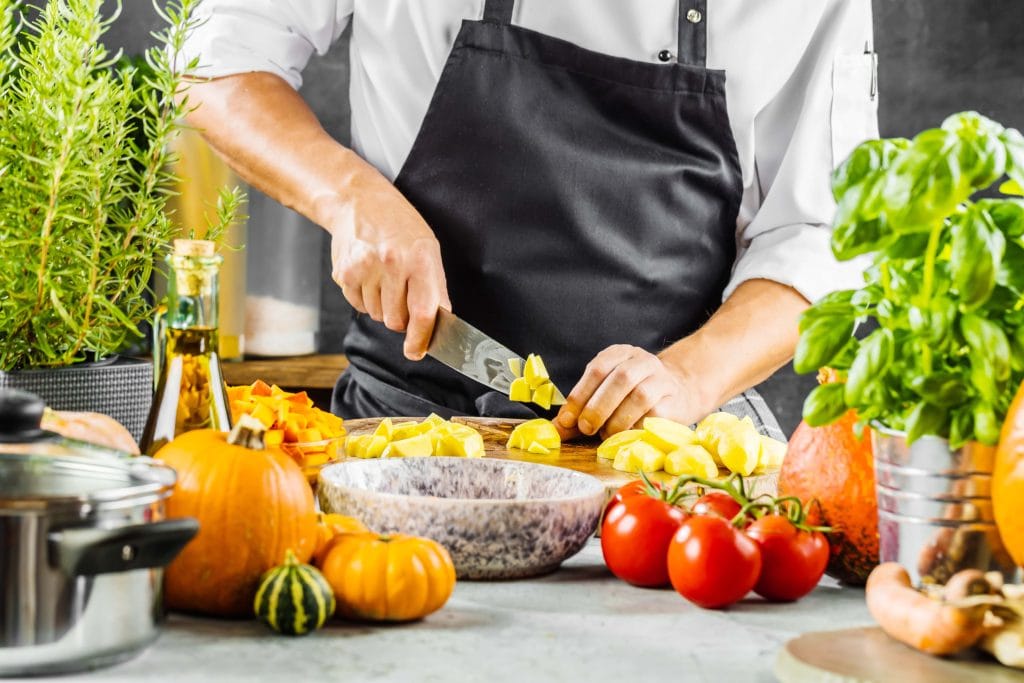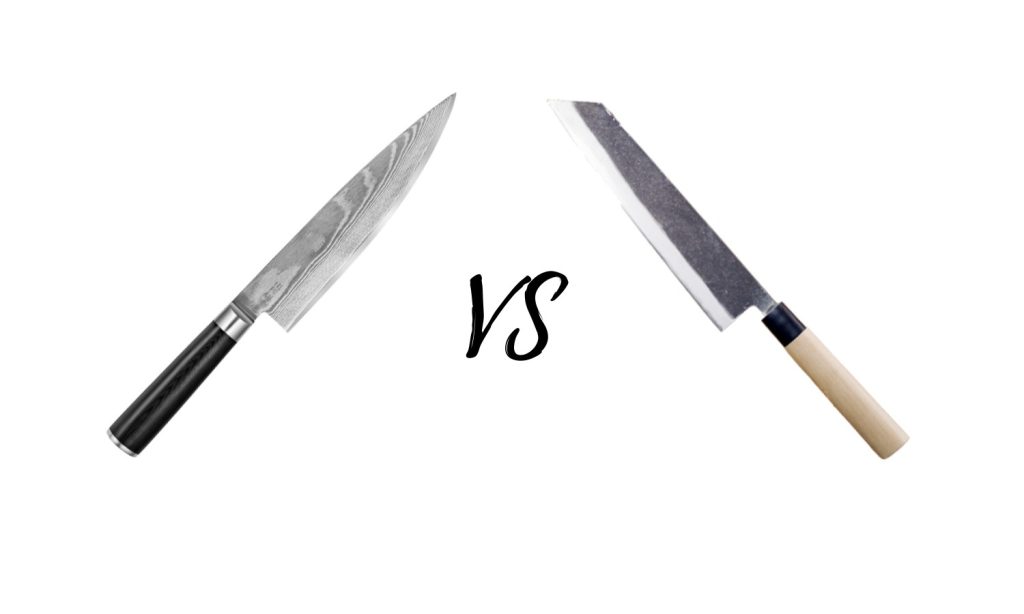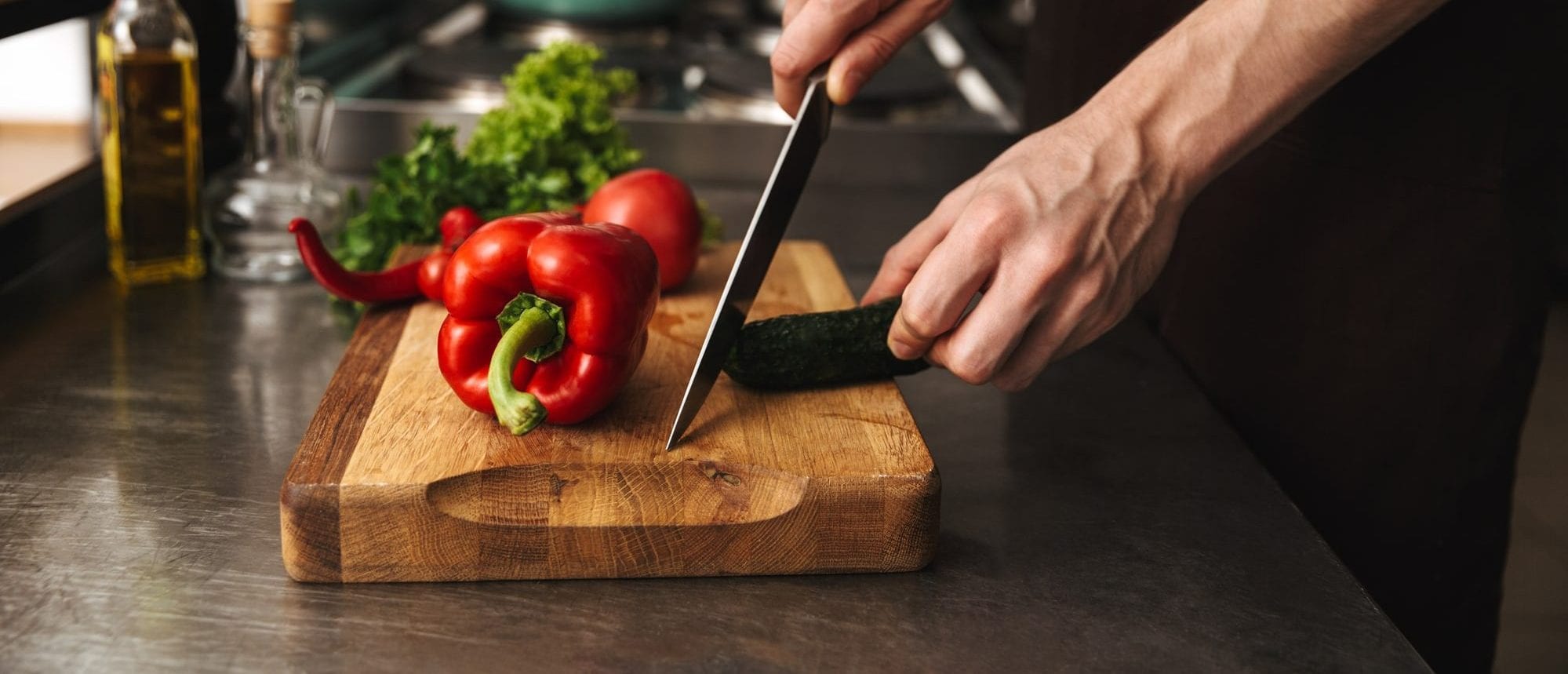Whether you’re a budding new chef or a seasoned pro, you’ve probably encountered the kiritsuke VS chef’s knife debate somewhere along the way. While both tools can be endlessly useful in the right kitchen, it’s important to understand the difference between the two before making a decision about which one is right for you.
On this page, we’ll be comparing kiritsuke knives to traditional chef’s knives. We’ll cover what each knife is good for, how they’re different, and how to make a decision that works for you.

Kiritsuke Overview
Kiritsuke knives aren’t quite as well-known as their double-beveled counterparts, gyuto knives. Nor are they as ubiquitous as chef’s knives. What they are, though, is exceptionally useful in the right pair of hands.
They’re significantly longer than your average knife and have a flat blade edge and a pointed tip. At first glance, you’d be forgiven for thinking you were looking at a miniature sword!
Shape
The length and flat edge of kiritsuke knives can take some getting used to. However, it can make this type of knife incredibly handy when slicing longer cuts of vegetables or fish. In fact, vegetable and fish prep are two areas where the kiritsuke really shines.
Just don’t be surprised if you encounter a bit of a learning curve at first – there’s a degree of skill required.
Ease of Use
Way back when, kiritsuke were reserved for only the most skilled chefs in a kitchen. While anyone can pick one up these days, it’s worth keeping in mind that it may take some getting used to at first.
The unwieldy length and atypical balance are the two most obvious obstacles you’ll need to overcome. Most skilled chefs absolutely love kiritsuke knives when they try them.
Single-Bevel Sharpness
Only one edge of traditional kiritsuke knives is ever sharpened. This single-bevel design allows for superior levels of both sharpness and precision when cutting. The food you slice is moved in one direction which makes it easier to achieve thinner, more intricate cuts for elegant Japanese cuisine.
Double-beveled variants of the kiritsuke do exist and are called “kiritsuke gyuto” by Japanese knife manufacturers. They can be easier to handle for western chefs.
Kiritsuke Knives Uses
- Preparing soft or raw fish, especially longer cuts
- Slicing and dicing vegetables
- Slicing larger, bone-free cuts of meat
- Miscellaneous kitchen tasks
Kiritsuke Basic Stats
- 9.5 – 13 inches blade length
- 1 – 2mm blade thickness
- An HRC between 59 and 63
Chef’s Knife Overview
Most western cooks will feel right at home using a chef’s knife. Their weight, size, and general balance are very common in kitchens throughout Europe and the United States. They’re typically much shorter than kiritsuke knives and usually feature a sharp tip for more precise cuts and incisions.
If you’re aiming for versatility above all else, it’s hard to go wrong with a good chef’s knife.

Chef’s Knife Shape
The legacy of traditional French cooking is clear as day in the design of a typical chef’s knife. They’re perfect for jobs such as julienning vegetables, preparing garlic, or slicing cuts of meat.
Ease for Beginners
Those new to kitchen work will love the simplicity and familiar nature of a standard chef’s knife. If you’re looking to find a knife with a relatively low barrier for entry, this is probably the option to go for.
The Double-Bevel Difference
One key point of difference between kiritsuke knives and chef’s knives is that many western chef’s knives feature a double-bevel edge. This makes them marginally less sharp on average, but does mean that they cut more predictably and require slightly less skill to use overall.
Consider your experience level when making a decision.
Chef’s Knife Uses:
- Practically all basic kitchen tasks
- Mincing, dicing, slicing, crushing
- More precise incisions and cuts (to an extent)
- Peeling vegetables
Chef’s Knife Basic Stats:
- Blades 6 – 12 inches long (12 inches will feel to big for newbies)
- Blades ideally 0.25mm thick
- HRC of 57 to 62
Kiritsuke VS Chef’s Knife – What’s the Difference?
While both tools can be versatile kitchen aids in the right set of hands, there’s actually a fair bit of difference between the two. You won’t necessarily be able to use a chef’s knife and a kiritsuke knife interchangeably.
Those who prioritize versatility above all else should probably opt for a chef’s knife in this instance. This is especially true for beginners who will find a kiritsuke knife hard to handle. More experienced chefs who need superior sharpness and extra precision when slicing long cuts of fish or veg will absolutely love a kiritsuke knife.
| Knife | Kiritsuke | Chef’s Knife |
| Blade Length | 9.5 – 13 inches | 6-12 inches (usually 6-8, though) |
| Blade Thickness | 1 – 2 mm | Ideal thickness of 0.25 mm |
| Flexibility | Low | Varies but typically low |
| HRC | 59 – 63 | 57 – 62 |
| Main Purpose | Very uniform, thin, and long cuts in raw fish. General vegetable prep. Intricate work. | General purpose tasks – slicing, mincing, dicing. |
Which One is for Me?
How often do you work with more delicate cuts of fish? How important is it to you that your cuts are razor-thin and precise every single time? If you answered “often” and “very important” to these questions, a kiritsuke knife might just be for you. That is, if you’ve got the requisite skills to handle it properly.
Looking for something a little more well-balanced for everyday kitchen tasks? Go with a chef’s knife!
Kiritsuke Recommendation
This is probably our favorite kiritsuke knife available in 2022:
– Mitsumoto Sakari 8-Inch Japanese Kiritsuke Chef Knife
Its balance, sharpness, and overall performance are remarkable. You get a lifetime warranty too!
– Find the best kiritsuke knife.
Chef’s Knife Recommendation
This chef’s knife is truly excellent:
– Victorinox Fibrox Pro, 8 Inch Chef’s Knife
We love the way it feels in the hand!
Check out our guide to the best chef’s knives.

Final Thoughts
We hope you leave this article feeling a bit more prepared to find a knife that works for you. The kiritsuke VS chef’s knife question is less complex than first meets the eye. Happy cooking!




Post Your Thoughts